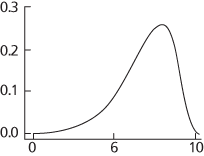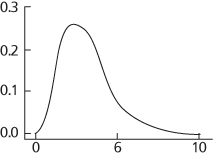The amount of asymmetry of a distribution. One measure of skewness is the coefficient of skewness, which is defined to be equal to μ3/(μ2)3/2, where μ2 and μ3 are the second and third moments about the mean. This measure is zero if the distribution is symmetrical about the mean. If the distribution has a long tail to the left, as in the top figure, it is said to be skewed to the left and to have negative skewness, because the coefficient of skewness is negative. If the distribution has a long tail to the right, as in the second figure, it is said to be skewed to the right and to have positive skewness, because the coefficient of skewness is positive. A skew distribution is one that is skewed to the left or skewed to the right.

Skewed to the left

Skewed to the right
An expression of the degree of asymmetry shown on a frequency distribution. A non-skewed distribution is a perfect, normal (Gaussian) distribution. Grain-size distributions are skewed positively where larger particles are more numerous than fine ones, or negatively where finer particles exceed coarse within the distribution.
A measure of the degree of asymmetry of the distribution of a random variable; the standardized third moment of the distribution, defined as
where μ is the mean and σ is the standard deviation. For a symmetrical distribution γ = 0 and the median of the distribution equals its mean. In a distribution with positive skewness the median is below the mean, and with negative skewness the median is above the mean. For example, the empirical distribution of income across the population in both developed and less developed countries exhibits positive skewness: a large proportion of income accrues to a small proportion of the population.
- channelization
- channelized flow
- channel management
- channel mobility
- channel operator
- channel order
- channel roughness
- channel stopper
- channel switching
- channel time response
- Channel Tunnel
- channel wave
- chaos
- chaos theory
- chaotic dynamics
- chaotic orbit
- chaotic reaction
- chaotic terrain
- CHAP
- chaparral
- chaperone
- Chapman estimator
- Chapman, Sydney
- Chapman, Sydney (1888–1970)
- Chapman–Kolmogorov equation